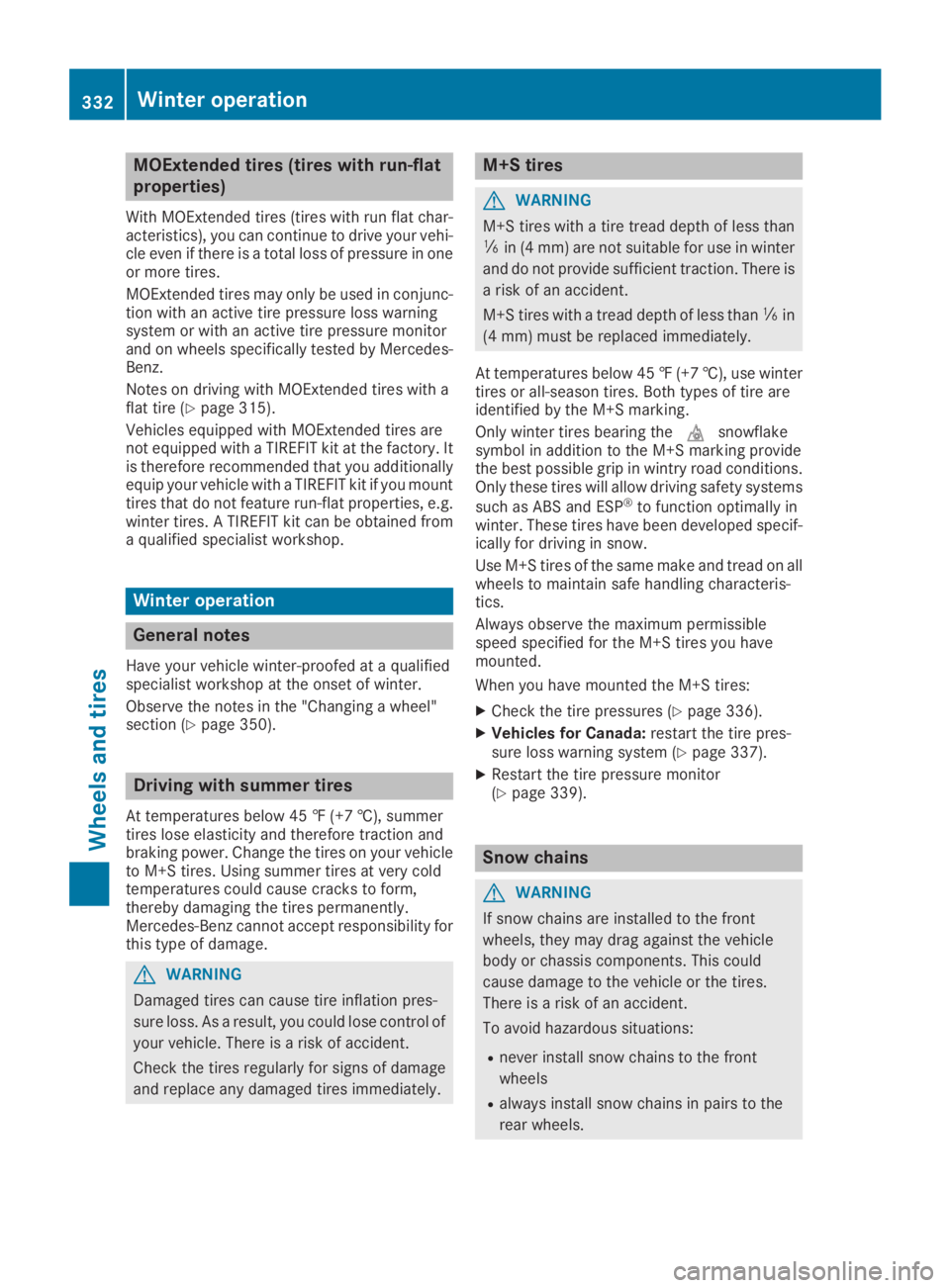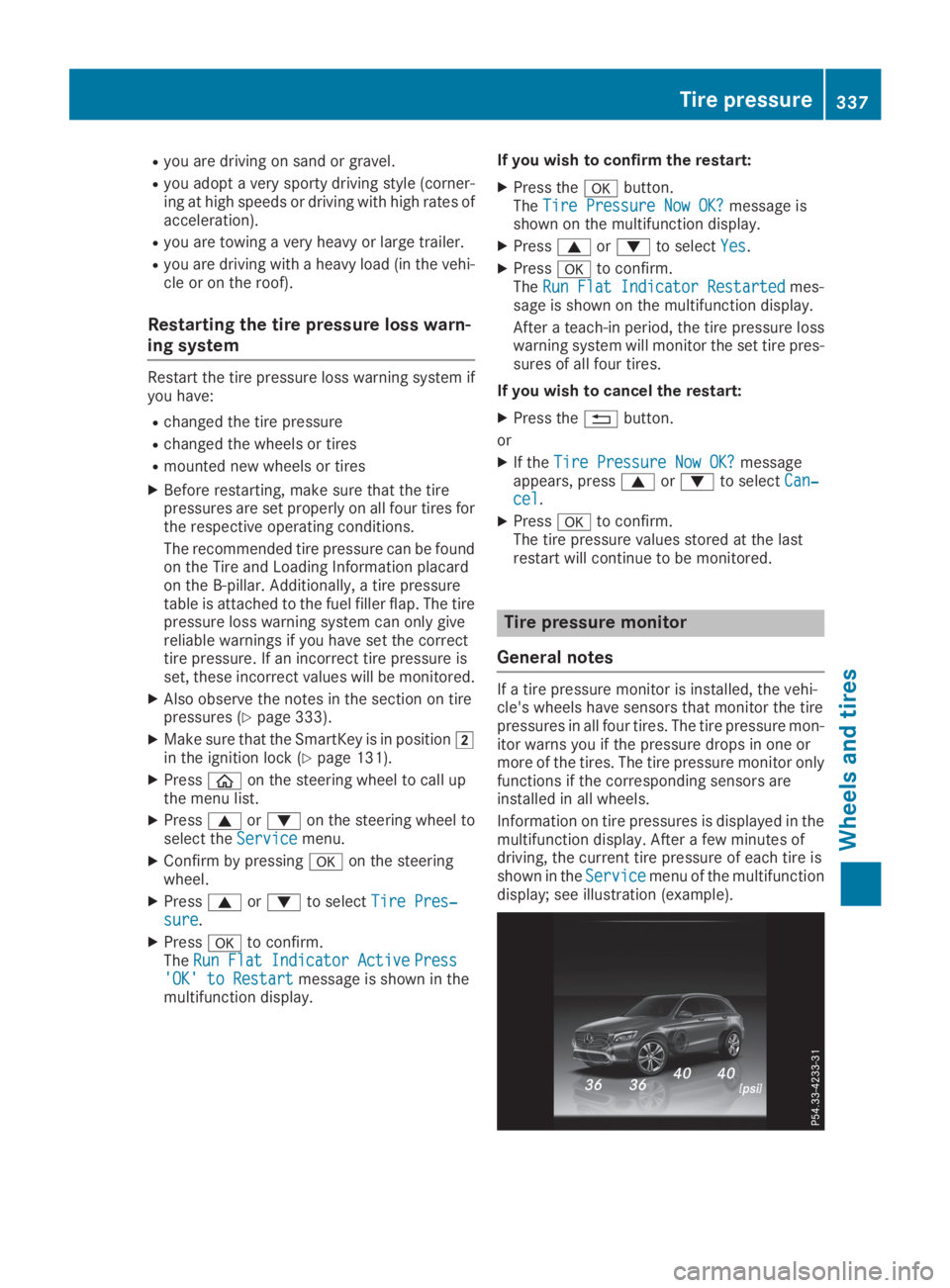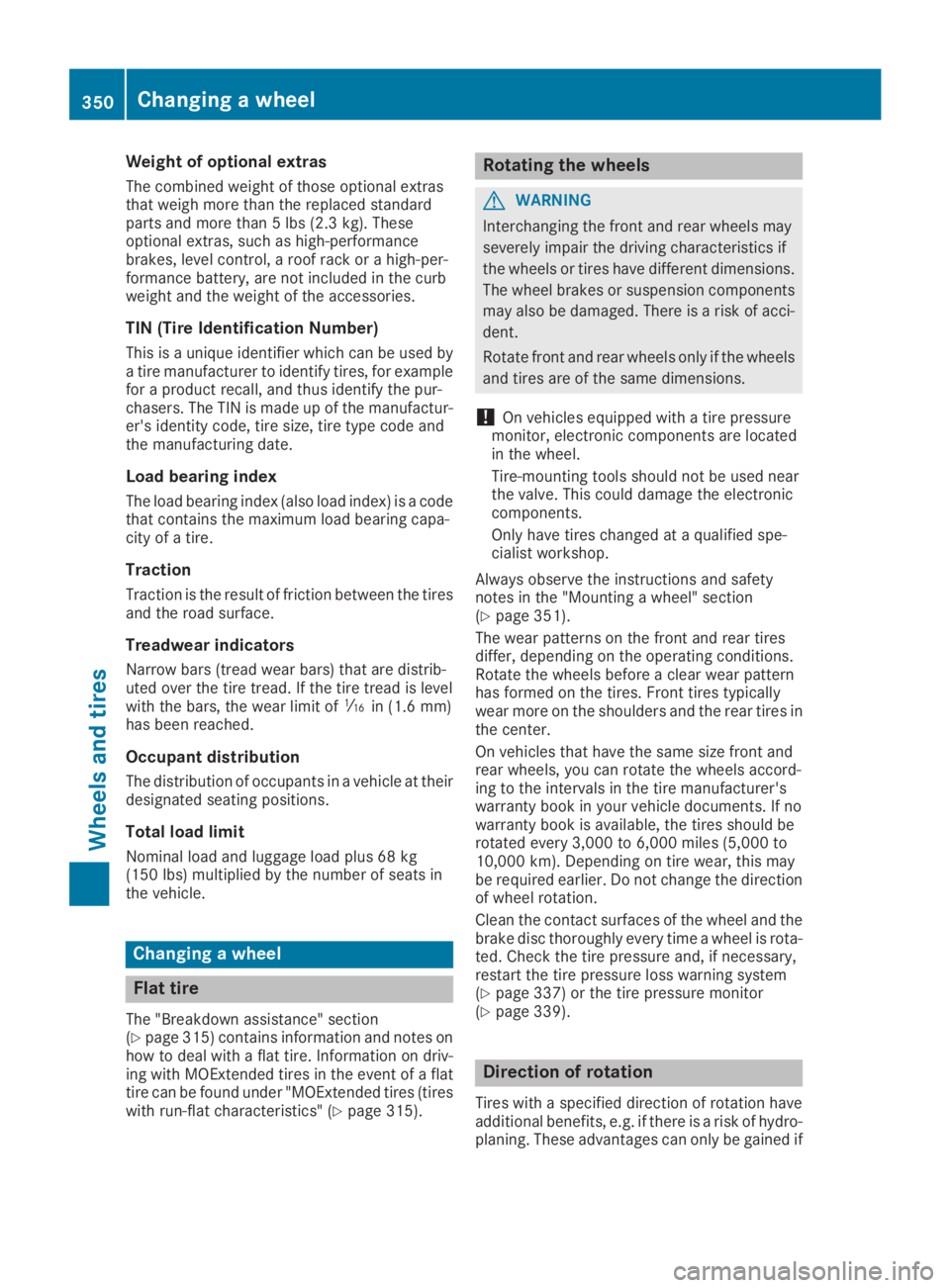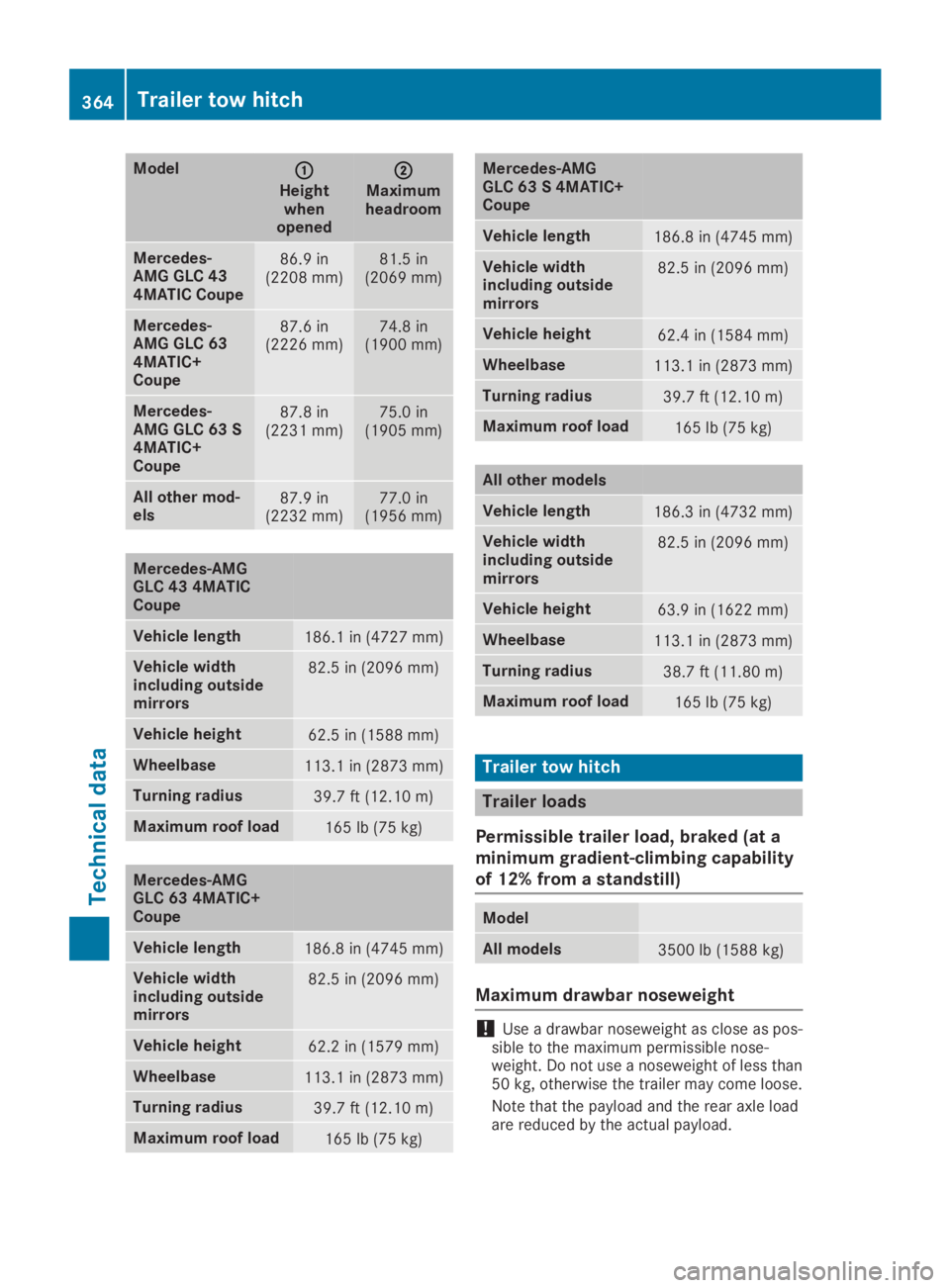Page 334 of 370

MOExtended tires (tires with run-flat
properties)
With MOExtended tires (tires with run flat char-acteristics), you can continue to drive your vehi-cle even if there is a total loss of pressure in oneor more tires.
MOExtended tires may only be used in conjunc-tion with an active tire pressure loss warningsystem or with an active tire pressure monitorand on wheels specifically tested by Mercedes-Benz.
Notes on driving with MOExtended tires with aflat tire (Ypage 315).
Vehicles equipped with MOExtended tires arenot equipped with a TIREFIT kit at the factory. Itis therefore recommended that you additionallyequip your vehicle with a TIREFIT kit if you mounttires that do not feature run-flat properties, e.g.winter tires. A TIREFIT kit can be obtained froma qualified specialist workshop.
Winter operation
General notes
Have your vehicle winter-proofed at a qualifiedspecialist workshop at the onset of winter.
Observe the notes in the "Changing a wheel"section (Ypage 350).
Driving with summer tires
At temperatures below 45 ‡ (+7 †), summertires lose elasticity and therefore traction andbraking power. Change the tires on your vehicleto M+S tires. Using summer tires at very coldtemperatures could cause cracks to form,thereby damaging the tires permanently.Mercedes-Benz cannot accept responsibility forthis type of damage.
GWARNING
Damaged tires can cause tire inflation pres-
sure loss. As a result, you could lose control of
your vehicle. There is a risk of accident.
Check the tires regularly for signs of damage
and replace any damaged tires immediately.
M+S tires
GWARNING
M+S tires with a tire tread depth of less than
�
Page 339 of 370

Ryou are driving on sand or gravel.
Ryou adopt a very sporty driving style (corner-ing at high speeds or driving with high rates ofacceleration).
Ryou are towing a very heavy or large trailer.
Ryou are driving with a heavy load (in the vehi-cle or on the roof).
Restarting the tire pressure loss warn-
ing system
Restart the tire pressure loss warning system ifyou have:
Rchanged the tire pressure
Rchanged the wheels or tires
Rmounted new wheels or tires
XBefore restarting, make sure that the tirepressures are set properly on all four tires forthe respective operating conditions.
The recommended tire pressure can be foundon the Tire and Loading Information placardon the B-pillar. Additionally, a tire pressuretable is attached to the fuel filler flap. The tirepressure loss warning system can only givereliable warnings if you have set the correcttire pressure. If an incorrect tire pressure isset, these incorrect values will be monitored.
XAlso observe the notes in the section on tirepressures (Ypage 333).
XMake sure that the SmartKey is in position�Hin the ignition lock (Ypage 131).
XPress�
Page 352 of 370

Weight of optional extras
The combined weight of those optional extrasthat weigh more than the replaced standardparts and more than 5 lbs (2.3 kg). Theseoptional extras, such as high-performancebrakes, level control, a roof rack or a high-per-formance battery, are not included in the curbweight and the weight of the accessories.
TIN (Tire Identification Number)
This is a unique identifier which can be used bya tire manufacturer to identify tires, for examplefor a product recall, and thus identify the pur-chasers. The TIN is made up of the manufactur-er's identity code, tire size, tire type code andthe manufacturing date.
Load bearing index
The load bearing index (also load index) is a codethat contains the maximum load bearing capa-city of a tire.
Traction
Traction is the result of friction between the tiresand the road surface.
Treadwear indicators
Narrow bars (tread wear bars) that are distrib-uted over the tire tread. If the tire tread is levelwith the bars, the wear limit of�
Page 358 of 370

Information regarding technical data
iThe data stated here specifically refers to avehicle with standard equipment. Consult anauthorized Mercedes-Benz Center for thedata for all vehicle variants and trim levels.
Vehicle electronics
Installing wireless devices and mobile
phones
GWARNING
The electromagnetic radiation from two-way
radios can interfere with the vehicle electron-
ics if two-way radios are manipulated or ret-
rofitted incorrectly. This could jeopardize the
operating safety of the vehicle. There is a risk
of an accident.
You should have all work on electrical and
electronic components carried out at a quali-
fied specialist workshop.
GWARNING
If you incorrectly operate two-way radios in
the vehicle, the electromagnetic radiation
may interfere with the vehicle electronics, for
example if:
Rthe two-way radio is not connected to an
exterior antenna
Rthe exterior antenna is not correctly moun-
ted or is not low-reflection
This could jeopardize the operating safety of
the vehicle. There is a risk of an accident.
Have the low-reflection exterior antenna
installed at a qualified specialist workshop.
Always connect two-way radios to the low-
reflection exterior antenna when operating in
the vehicle.
!The operating permit may be invalidated ifthe instructions for installation and use oftwo-way radios are not observed.
In particular, the following conditions must becomplied with:
Ronly approved wavebands may be used.
Robserve the maximum permissible outputin these wavebands.
Ronly approved antenna positions may beused.
Excessive levels of electromagnetic radiationmay cause damage to your health and the healthof others. Using an exterior antenna takes intoaccount current scientific discussions relatingto the possible health hazards that may resultfrom electromagnetic fields.
Approved antenna positions
�CFront roof area
�DRear roof area
�
Page 366 of 370

Model�C�C
Heightwhenopened
�D�D
Maximumheadroom
Mercedes-AMG GLC 434MATIC Coupe
86.9 in(2208 mm)81.5 in(2069 mm)
Mercedes-AMG GLC 634MATIC+Coupe
87.6 in(2226 mm)74.8 in(1900 mm)
Mercedes-AMG GLC 63 S4MATIC+Coupe
87.8 in(2231 mm)75.0 in(1905 mm)
All other mod-els87.9 in(2232 mm)77.0 in(1956 mm)
Mercedes-AMGGLC 43 4MATICCoupe
Vehicle length186.1 in (4727 mm)
Vehicle widthincluding outsidemirrors
82.5 in (2096 mm)
Vehicle height62.5 in (1588 mm)
Wheelbase113.1 in (2873 mm)
Turning radius39.7 ft (12.10m)
Maximum roof load165 lb (75 kg)
Mercedes-AMGGLC 63 4MATIC+Coupe
Vehicle length186.8 in (4745 mm)
Vehicle widthincluding outsidemirrors
82.5 in (2096 mm)
Vehicle height62.2 in (1579 mm)
Wheelbase113.1 in (2873 mm)
Turning radius39.7 ft (12.10m)
Maximum roof load165 lb (75 kg)
Mercedes-AMGGLC 63 S 4MATIC+Coupe
Vehicle length186.8 in (4745 mm)
Vehicle widthincluding outsidemirrors
82.5 in (2096 mm)
Vehicle height62.4 in (1584 mm)
Wheelbase113.1 in (2873 mm)
Turning radius39.7 ft (12.10m)
Maximum roof load165 lb (75 kg)
All other models
Vehicle length186.3 in (4732 mm)
Vehicle widthincluding outsidemirrors
82.5 in (2096 mm)
Vehicle height63.9 in (1622 mm)
Wheelbase113.1 in (2873 mm)
Turning radius38.7 ft (11.80m)
Maximum roof load165 lb (75 kg)
Trailer tow hitch
Trailer loads
Permissible trailer load, braked (at a
minimum gradient-climbing capability
of 12% from a standstill)
Model
All models3500 lb (1588 kg)
Maximum drawbar noseweight
!Use a drawbar noseweight as close as pos-sible to the maximum permissible nose-weight. Do not use a noseweight of less than50 kg, otherwise the trailer may come loose.
Note that the payload and the rear axle loadare reduced by the actual payload.
364Trailer tow hitch
Technical data